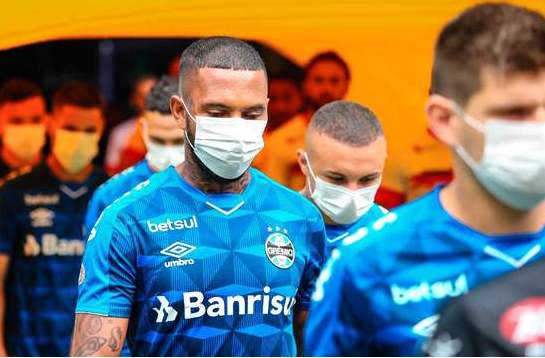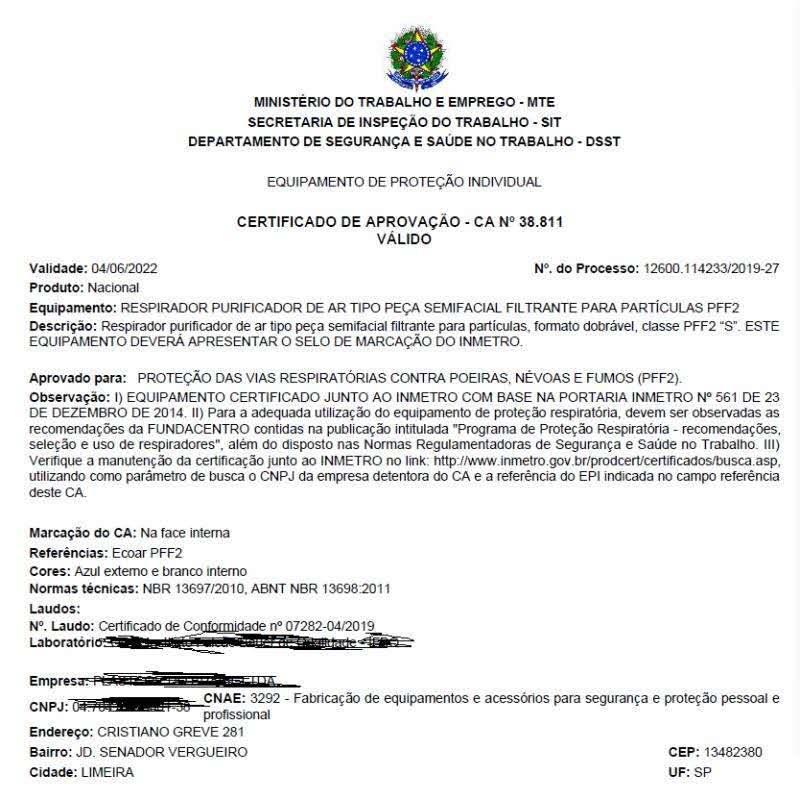巴西 - 个人防护口罩需要做 NR6认证
目前出口巴西2个途径:
1按照巴西3月20的通知和5月8日发布的11437防护设备法令,可以通过不进行认证把产品销往巴西,该通知规定免于认证的期限是一年内。但需要提供 ABNT NBR 13698 测试报告并申请劳工部的ca证书。
Parágrafo único. Caso o fornecedor opte por não certificar o produto, deve manter
registros do cumprimento dos requisitos técnicos previstos, por meio de ensaios realizados em
laboratório acreditado pela Cgcre/Inmetro ou por membro dos acordos de reconhecimento mútuo do
International Laboratory Accreditation Cooperation – ILAC, ou outro critério que vier a ser
determinado pela Agência Nacional de Vigilância Sanitária ou Secretaria Especial da Previdência e do
Trabalho do Ministério da Economia.
2 按照正常要求,先申请ocp出具的产品合格证书,再去申请带有劳动和就业部官方国家机构签发的关于工作安全与健康的批准证书ca证书。ca证书有效期为5年。
CA证书申请模式
CA Model 一: 无需INMETRO合格证书即可直接申请方式(只针对防范低风险),一年期内。
CA Modle 二: 需要获得INMETRO合格证书后再申请,5年期。
CA Model一 :
A 申请需要的条件
-
1 巴西进口商(每个进口商都需要申请)
-
2 营业执照/生产许可证,自由销售证书,ISO9001证书等
-
3 公司信息资料,产品资料(产品照片,说明书,技术文件,图纸,包装等)
-
4 NBR13698测试报告或ILAC CNAS资质实验室出具的EN149报告(一年内)
-
5 部分文件必须是葡文,且部分文件必须翻译成葡文并进行公证。
B 申请周期 资料准备齐全后,4周—6周; 如果EN149报告在MTE审核时不被认可或样品在巴西测试不合格,时间顺延。
C 申请流程
1 工厂提交基本信息和相关资料,以分析申请CA可行性
2 双方协商达成共识后,签署委托服务协议。
3 资料准备(如果需要送样去巴西测试的,需要准备样品)4 由进口商提交整套申请资料到MTE进行申请
5 MTE审核资料,如果有缺少或不符合,需要补齐
6 审核完成,MTE出CA证书。
D 费用
1 CA申请服务费
1.1资料收集 整理 审核 翻译 公证1.2全程操作,协助,监督/跟进1.3其他
CAModel二: 增加了INMETRO合格证书环节,其他都一样INMETRO认证要求,需要对工厂进行验厂,产品需要在符合要求的实验室进行测试,也
需要巴西进口商/BRH
A 时间 6-8周(验厂+测试)B 费用
工厂审核, 审核工程师差旅,产品测试
C 流程
1 提交申请 2安排工厂审核 3产品测试 4
D 年度BRH服务费
OCP出合格证书 5 进口商/BRH提交注册
接受OCP审核,向INMETRO提交申请资料并完成注册,承担工厂在巴西的相关法律责任,以 及为巴西与工厂之间的联系和转达,缴纳INMETRO注册费。
巴西 - 医用口罩需要做 ANVISA认证
医用口罩检测标准:ABNT NBR 15052 检测,需要指定医疗器械代表人(BRH)
巴西ANVISA申请流程
步骤 1 按照 ANVISA RDC185,对产品进行分类,一般会有 2 种注册方式: 登记或者注册;低
风险的1 类和2类一般属于简单登记,但高风险的1类和2类,以及所有的3类,4类产品,是属 于完整的注册(登记和注册的区别在于是否要 BGMP 验厂)
步骤 2 指定一个公司成为你的证书持有人(BRH);国外制造商可以通过这个托管的 BRH进行授权巴西经销商进口和销售产品.
步骤 3 授权 BRH 提交注册申请和文件资料给 ANVISA;你的 BRH 将维护注册和保持BGMP(只适用需要 BGMP 的客户)
步骤 4 某些设备需要 INMETRO 认证。电子电器类医疗产品进行巴西以外的测试通常是 由 ILAC 认证实验室进行(CB 方案不接受)。
步骤 5 I 类和 II 类设备制造商(包括登记和注册)只须符合 BGMP 基本要求。(ANVISA不会进行验厂。***)III 级和 IV 级设备制造商必须遵守 ANVISA 的 BGMP 验厂,由 ANVISA派出官员进行.BGMP 每 2 年检查一次,费用也是每两年支付一次。
步骤 6 I 和 II 类 cadastro 设备准备了简短的应用程序。 将法律文件以及建议的标签和IFU 发送给 BRH,以备将来进行 ANVISA 审核时备案。 I 至 IV 类注册商准备技术文件,其中 包括临床数据,临床研究(如果适用),根据 RDC 185/2001 中的附件 III,A,B 和 C 部分在您 的设备上提供的信息,以及建议的标签和说明 在附件 III B 部分中找到使用的方法。
步骤 7 对于所有设备,可以通过三种方式来满足以下要求:1)获得免费销售证书(CFS) 或设备注册证书,以证明您的卫生部已获得本国的批准; 2)在其他两个市场上显示注册证 明,并提供您的设备未获得本国批准的理由; 3)适用设备的 INMETRO 证书。(口罩只需满 足部分要求)
步骤 8 所有整套文件必须符合 ANVISA 要求,其中部分文件必须是葡萄牙文,且翻译件 必须经过公证。
步骤 9 对于所有的等级,ANVISA 都会审查注册申请。 如果获得批准,ANVISA 将在《官 方日报》(DOU)中发布注册号。注册有效期为 5 年。 续证必须在到期前一年开始。


Annex I of NR6-List of Personal Protective Equipments
A – HEAD PROTECTION
A.1 – Helmet
a) helmet to protect against impact of objects on skull;
b) helmet to protect against electrical shocks;
c) helmet to protect skull and face against thermal agents.
A.2 – Cap or balaclava
a) caps to protect skull and neck against the thermal risks;
b) caps to protect skull, face and neck against chemical agents;
c) caps to protect head and neck against moisture resulting from water-using operations.
B – FACE AND EYE PROTECTION
B.1 – Goggles
a) goggles to protect eyes against impacts of flying particles;
b) goggles to protect eyes against bright lights;
c) goggles to protect eyes against ultraviolet radiation;
d) goggles to protect eyes against infrared radiation.
e) mesh goggles for limited eye protection against impacts of flying particles;
B – FACE AND EYE PROTECTION
B.1 – Goggles
a) goggles to protect eyes against impacts of flying particles;
b) goggles to protect eyes against bright lights;
c) goggles to protect eyes against ultraviolet radiation;
d) goggles to protect eyes against infrared radiation.
e) mesh goggles for limited eye protection against impacts of flying particles;
B.2 - Face shield
a) face shield to protect face against impacts of flying particles;
b) face shield to protect face against infrared radiation;
c) face shield to protect eyes against bright light;
d) face shield to protect face against the thermal risks;
e) face shield to protect face against ultraviolet radiation
B.3 - Welding helmet
a) welding helmet to protect face and eyes against impacts of flying particles, ultraviolet radiation, infrared radiation and intense light.
C - HEARING PROTECTION
C.1 - Hearing protector
a) circumaural hearing protector to protect auditory system against sound pressure levels above levels given in Annex 1 and 2 of NR-15.
b) insert-type hearing protector to protect auditory system against sound pressure levels above levels given in Annex 1 and 2 of NR-15.
c) semi-aural hearing protector to protect auditory system against sound pressure levels above levels given in Annex 1 and 2 of NR-15.
D - RESPIRATORY PROTECTION
D.1 - Non-powered air purifying respirator:
a) semi-facial filtered (PFF1) to protect airways against dusts and mists;
b) semi-facial filtered (PFF2) to protect airways against dusts, mists and fumes;
c) semi-facial filtered (PFF3) to protect airways against dusts, mists, fumes and radionuclides;
d) quarter, semi and full facial mask with particulate material filter; P1 type to protect airways against dust and mists; P2 type for protection against dusts, mists and fumes; P3 type for protection against dusts, mists, fumes and radionuclides;
e) quarter, semi or full facial mask with chemical and/or combined filter to protect airways against gases and vapors and/or particulate material.
D.2 - Powered air purifying respirator:
a) respiratory protection cap, hood or helmet without facial seal to protect airways against dusts, fumes and radionuclides and/or against gases and vapors;
b) semi or full facial mask with facial seal to protect airways against dusts, fumes and radionuclides and/or against gases and vapors.
D.3 - Supplied air respirators with compressed airline:
a) continuous flow air supplied hood or helmet without facial seal to protect airways in atmospheres with concentration greater than 12,5% oxygen;
b) continuous flow air supplied hood or helmet without facial seal to protect airways in sand blasting operations and in atmospheres with concentration greater than 12,5% oxygen;
c) semi or full facial mask with facial seal to protect airways in atmospheres with concentration greater than 12,5% oxygen;
d) semi or full facial mask with positive pressure valve to protect airways in atmospheres with concentration greater than 12,5% oxygen;
e) full face mask combined with an auxiliary cylinder with positive pressure valve to protect airways in atmospheres with concentration less than or equal to 12,5%, i.e, in atmospheres Immediately Dangerous to Life and Health (IPVS).
D.4 – Supplied air respirators with autonomous mask:
a) open circuit demand with positive pressure to protect airways in atmospheres with concentration less than or equal to 12,5%, i.e, in atmospheres Immediately Dangerous to Life and Health (IPVS);
b) closed circuit demand with positive pressure to protect airways in atmospheres with concentration less than or equal to 12,5%, i.e, in atmospheres Immediately Dangerous to Life and Health (IPVS).
D.5 - Escape respirator
a) nozzle type escape respirator to protect airways against gases and vapors and/or particulate matter under the conditions of escape from atmospheres Immediately Dangerous to Life and Health (IDLH).
E - BODY PROTECTION
E.1 – Clothings
a) Clothings to protect torso against thermal risks;
b) Clothings to protect torso against mechanical risks;
c) Clothings to protect torso against chemical agents;
d) Clothings to protect torso against radioactive risks;
e) Clothings to protect torso against moisture from rainfall; (Altered by Ordinance MTB 870/2017)
f) Clothings to protect torso against moisture resulting from water-using operations.
E.2 - Use of bulletproof vest is permitted for watchmen who work carrying a firearm, to protect the torso against mechanical risks.
F - UPPER LIMB PROTECTION
F.1 - Gloves
a) gloves to protect hands against abrasion and excoriation;
b) gloves to protect hands against cuts and pierce;
c) gloves to protect hands against electrical shocks;
d) gloves to protect hands against thermal agents;
e) gloves to protect hands against biological agents;
f) gloves to protect hands against chemical agents;
g) gloves to protect hands against vibration;
h) gloves for protection against moisture resulting from water-using operations;
i) gloves to protect hands against ionized radiation.
F.2 - Protective cream
a) protective cream to protect the upper limb against chemical agents.
F.3 - Sleeve
a) sleeve to protect arm and forearm against electrical shock;
b) sleeve to protect arm and forearm against abrasion and excoriation;
c) sleeve to protect arm and forearm against cuts and pierce;
d) sleeve to protect arm and forearm against moisture resulting from water-using operations;
e) sleeve to protect arm and forearm against thermal agents;
f) sleeve to protect arm and forearm against chemical agents.
F.4 - Armband
a) armband to protect forearm against cuts;
b) armband to protect forearm against excoriation.
F.5 - Finger cot
a) finger cot to protect fingers against abrasion and excoriation.
G - LOWER LIMB PROTECTION
G.1 - Footwear
a) footwear for protection against impact of falling objects on the toes;
b) footwear to protect feet against electrical energy;
c) footwear to protect feet against thermal agents;
d) footwear to protect feet against abrasion and excoriation;
e) footwear to protect feet against cuts and pierce;
f) footwear to protect feet and legs against moisture from operations with the use of water;
g) footwear to protect feet and legs against chemical agents.
G.2 - Sock
a) sock to protect feet against low temperatures.
G.3 - Gaiter
a) gaiter to protect legs against abrasion and excoriation;
b) gaiter to protect legs against thermal agents;
c) gaiter to protect legs against chemical agents;
d) gaiter to protect legs against cuts and pierce;
e) gaiter to protect legs against moisture resulting from water-using operations.
G.4 - Trouser
a) trouser to protect legs against abrasion and excoriation;
b) trouser to protect legs against chemical agents;
c) trouser to protect legs against thermal agents;
d) trouser to protect legs against moisture resulting from water-using operations.
e) trouser to protect legs against moisture from rainfall; (Inserted by Ordinance MTB 870/2017)
H - WHOLE BODY PROTECTION
H.1 - Coverall
a) coverall to protect torso and upper and lower limbs against thermal agents;
b) coverall to protect torso and upper and lower limbs against chemical agents;
c) coverall to protect torso and upper and lower limbs against moisture resulting from water-using operations.
d) coverall to protect torso and upper and lower limbs against moisture from rainfall; (Inserted by Ordinance MTB 870/2017)
H.2 - Full body clothing
a) clothing to protect whole body against chemical risks;
b) clothing to protect whole body against moisture from operations with the use of water;
c) conductive clothing to protect whole body against electrical shock;
d) clothing to protect whole body against moisture from rainfall. (Inserted by Ordinance MTB 870/2017)
I - FALL PROTECTION (DUE TO LEVEL DIFFERENCE)
I.1 - Safety belt with fall arrest device
a) safety belt with fall arrest device to protect user against fall in operations with vertical and horizontal movement.
I.2 - Safety belt with lanyard
a) safety belt with lanyard to protect user against fall when working at height
b) safety belt with lanyard to protect user against fall while positioning himself/herself when working at height
